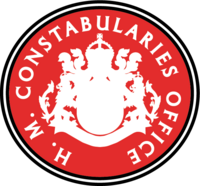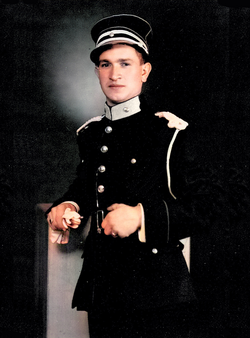Policing in Great Nortend: Difference between revisions
(→Ranks) |
|||
| Line 150: | Line 150: | ||
==Uniform and equipment== | ==Uniform and equipment== | ||
[[File:GNPolice2.png|thumb|250px|A police intendent in [[Nortish dress codes#Undress|undress]] uniform.]] | [[File:GNPolice2.png|thumb|250px|A police intendent in [[Nortish dress codes#Undress|undress]] uniform.]] | ||
As a civilian service, policemen wear blue | As a civilian service, policemen wear blue tunics as their daily [[Nortish dress codes|undress]] operational uniform, with knee boots and overalls and a peaked forage cap. Lady constables wear skirts instead of overalls. Many constabularies wear helmets as part of the police uniform when on the beat, instead of the forage cap. Instead of full dress or mess dress as worn by the [[War Office (Great Nortend)|Armed Forces]], civilian morning and evening dress are worn as appropriate when not on duty.<ref>''His Majesty's Constabulary Regulations'', Mich., 2 Alex. II.</ref> | ||
For personal equipment, all police officers carry a whistle, a wooden truncheon and handcuffs. Thin body armour | For personal equipment, all police officers carry a police whistle, a wooden truncheon and a pair of handcuffs. Policemen carry pistols; however, their use is very uncommon. Thin body armour is sometimes worn underneath the tunic to protect against shootings and stabbings; however, the low level of gun or knife violence generally means it is unnecessary.<ref name="Cabbat"/> | ||
Police vehicles vary between constabularies; however, most use types of dark blue or [[Erbonian English|swart]] saloons, fitted with a | Police vehicles vary between constabularies; however, most use types of dark blue or [[Erbonian English|swart]] saloons, fitted with a „Winkworth” police bell and a roof-mounted light box. Horse-drawn police vehicles have not been in use since the mid-20th century; however, mounted police are in very regular use. | ||
==List of constabularies== | ==List of constabularies== | ||
Revision as of 14:45, 3 August 2021
| His Majesty's Constabularies Office | |
|---|---|
 | |
| Office overview | |
| Jurisdiction | Great Nortend |
| Headquarters | Fettercourt, Lendert-with-Cadell, Great Nortend |
| Ministry | |
| Under-Clerk of Constabularies | Frederic de Pryde-Gisham |
| King's Clerk | Sir Aaron Billings |
| Parent ministry | H. M. Clerk's Office |
Regular policing in Great Nortend is undertaken by county and borough constabularies commanded by appointed commissioners answering to the county sheriff and thence to the King's lieutenant. All constabularies are under the ministerial jurisdiction the Constabularies Office of the King's Clerk who coordinates the regional constabularies on a national and inter-county level.
As officers of the Crown, police constables swear allegiance to the Sovereign in the exercise of his prerogative of ensuring peace are granted statutory and customary rights and privileges. For instance, despite being a civilian force, policemen are entitled to carry small arms,[1] and to an extent may search persons and property without a warrant. Their general duties involve deterring crime by patrolling the streets (“walking the beat”), investigating crime, dealing with breaches of the peace, enforcing the law and giving help to the public.
Organisation

The first police forces evolved from the mediaeval system of watchmen, constables and other parish officers who were charged with the maintenance of the peace. In the 19th century, this developed into a system of police constabularies by the Constabularies Act, 56 Edm. VII. which require the sheriff and yeomen of right of each county or borough to combine the existing ad hoc system of local policing into a centrally administered constabulary force.
The sixty-five constabularies formed under the Constabularies Act are organised on a county-by-county basis, under the ministerial control of the King's Clerk who has responsibility over domestic security and law enforcement.[2] This is exercised through the Under-Clerk for Constabularies who heads the Constabularies Office, a sub-office of the Clerk's Office. The Constabularies Office is the main liaison office between the Government and the police constabularies.
Structure
Operational policing is undertaken by bodies of constables known as constabularies, each whereof independent of another. There are sixty-five constabularies through the country.[2] Each has a particular territorial jurisdiction known as a constablewick. Most constabularies have a constablewick over an entire county. Twelve boroughs have their own independent constabularies, although most boroughs share their constabulary with the wider county.
Most constabularies are organised in a hierarchy of four levels :—[3]
- Parish
- There is a police house in most parishes. An Underconstable, Constable or Serjeant is in charge of the police house, assisted by lower ranks.
- Subdivision
- A subdivision consists of several parishes in a locality commanded by an officer of the rank of Intendent. A Superintendent is based in the largest settlement of the subdivision, where a police station is located.
- Division
- A division is a grouping of subdivisions corresponding to a hundred or a group of hundreds or a borough. It is commanded by the High Constable of the hundreds within the division. Most constabularies have around eight to ten divisions.
- Constablewick
- Commissioners, Under-Commissioners and Tipstaves operate from the constabulary headquarters. Each constabulary has a D. S. division (Detective Services division) and an S. S. division (Special Services division). The former is tasked with investigative and detective police work whilst the latter encompasses a variety of different branches such as the Dog Branch, the Mounted Branch, the Firearms Branch (often called the Gendarmery) and the Security Branch.
Ranks
The Constabularies Act did not abolish the traditional offices of constable, high constable and sheriff who were the officers of the peace for a parish, hundred/borough and county respectively. Rather, it formalised the existing system of ad hoc assistants, deputies and deputies of deputies over several different recognised offices, titled inter alia watchmen, underconstables, beadles, bailiffs, undertipstaves and tipstaves. This ensured that all such officers of the peace had a constable's customary powers.[2]
As such, any policeman may exercise his statutory powers anywhere in Great Nortend. Furthermore, the Lady Constables Act, 10 Edm. IX., permitted women to join constabularies for the first time, with most of the statutory and customary law powers of male constables. Lady constables are, however, restricted to the ranks of watchman, underconstable, constable and serjeant.[4]
Uniform and equipment

As a civilian service, policemen wear blue tunics as their daily undress operational uniform, with knee boots and overalls and a peaked forage cap. Lady constables wear skirts instead of overalls. Many constabularies wear helmets as part of the police uniform when on the beat, instead of the forage cap. Instead of full dress or mess dress as worn by the Armed Forces, civilian morning and evening dress are worn as appropriate when not on duty.[5]
For personal equipment, all police officers carry a police whistle, a wooden truncheon and a pair of handcuffs. Policemen carry pistols; however, their use is very uncommon. Thin body armour is sometimes worn underneath the tunic to protect against shootings and stabbings; however, the low level of gun or knife violence generally means it is unnecessary.[1]
Police vehicles vary between constabularies; however, most use types of dark blue or swart saloons, fitted with a „Winkworth” police bell and a roof-mounted light box. Horse-drawn police vehicles have not been in use since the mid-20th century; however, mounted police are in very regular use.
List of constabularies
- Aceshire Constabulary
- Almeshire Constabulary
- Barard Constabulary
- Barminstershire Constabulary
- Bentshire Constabulary
- Derhamshire Constabulary
- Eamshire Constabulary
- Enley Constabulary
- Essingfordshire Constabulary
- Fawnshire Constabulary
- Gortland Constabulary
- Harvickshire Constabulary
- Herstlow Constabulary
- Heymeadshire Constabulary
- Igoxeter Constabulary
- Larkshire Constabulary
- Leaton Constabulary
- Merst Constabulary
- Narland Constabulary
- Norsaxer Constabulary
- Poltland Constabulary
- Redwickshire Constabulary
- Seffet Constabulay
- Suthrepourdeland Constabulary
- Swent Constabulary
- Walecestershire Constabulary
- Teyshire Constabulary
- Towshire Constabulary
- County Allells Constabulary
- Cardenbridge Constabulary
- Mure Constabulary
- Bissex Constabulary
- Eastlord Constabulary
- Despenshire Constabulary
- Esxshire Constabulary
- Ganningshire Constabulary
- March Constabulary
- Minnerland Constabulary
- Rhightonshire Constabulary
- Rocklehamshire Constabulary
- Toleshire Constabulary
- Chepingstow Constabulary
- City Constabulary
- Echester Constabulary
- Essingford Constabulary
- Fawnslaughter Constabulary
- Fivewells Constabulary
- Gibbingham Constabulary
- Heymead Constabulary
- Keys Constabulary
- King's Rhighton Constabulary
- Limmes Cathedral Constabulary
- Limmes Constabulary
- Mast Constabulary
- Mooping Constabulary
- Oxley Constabulary
- Polton Constabulary
- Rhise Constabulary
- Scode Cathedral Constabulary
- Sulhampton Constabulary
- Sulthey Constabulary
- St. Cleaves Constabulary
- St. Peter's Constabulary
- Tretford Constabulary
- Hastican Constabulary
References
This page is written in Erbonian English, which has its own spelling conventions (colour, travelled, centre, realise, instal, sobre, shew, artefact), and some terms that are used in it may be different or absent from other varieties of English. |





